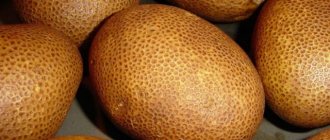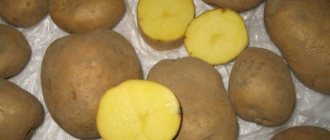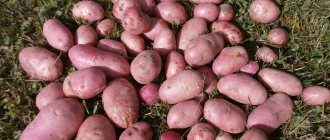Potato variety Milena: planting, cultivation, description, reviews and photos
Many vegetable growers grow potatoes in their garden plots. Moreover, early and super-early varieties of this vegetable crop are especially popular among summer residents.
This article talks about the super early potato variety Milena
, which is characterized by good yield, unpretentiousness to growing conditions, and excellent taste of root crops.
The content of the article:
History of the Milena potato variety: description of the variety Productivity of Milena potatoes Advantages and disadvantages Diseases and pests Milena potatoes: planting and cultivation Reviews of those who planted the Milena potato variety
Potatoes Milena: characteristics and description of the variety
Depending on weather conditions in a particular growing region, the root crops of this ultra-early potato variety ripen in 2.5-3 months.
Photo of Milena potatoes
The bushes are medium spreading with erect shoots, the height of which can reach 0.6 m. The stems are medium leafy. The foliage is typical of potato varieties, dark emerald green, with slightly wavy edges. The roots of the bushes of this variety are well developed, so from each bush you can collect up to 20-25 root crops with high marketability (91-95%).
Milena's root crops ripen approximately the same in size, their shape is round, their weight is 92-110 g. The skin is thin, the eyes are small, its color is yellow. The pulp is dense, creamy in color. The starch content in root vegetables is 12-14%.
The harvested Milena potato crop tolerates transportation well over long distances without losing its presentation and taste. The tubers are not watery and the flesh does not change color when cut. Root vegetables can be used for preparing first and second courses, baking, and frying.
Milena potatoes are highly resistant to the following diseases:
- nematode;
- viral diseases;
- potato cancer.
It is practically not affected by late blight on tops and root crops.
However, this potato has low resistance to rot and blackleg. The harvested crop is well stored, and no more than 5% of the root crops are damaged during storage.
Harvesting and storing white-fleshed varieties
Potatoes with white flesh are harvested depending on the variety and its ripening time. There are early varieties - such as: Milena, Leader, Timo and Lakomka. The Petersburg variety, Barin and Silvana are considered mid-season.
How and when to collect
The harvest is harvested when the tops turn yellow and fall down. A week before harvesting, it is advisable to remove it from the garden and schedule harvesting for a dry, sunny day. After digging, the potatoes are laid out in a shaded place to dry. If tubers are immediately selected for planting next year, then, on the contrary, they are placed in a sunny place.
If the collection is carried out manually, take into account how the planted variety grows. There are crops that grow wider, and there are potatoes that go deeper into the ground. Depending on this, the width of the soil around the bush is adjusted. To reduce the amount of potatoes cut with a shovel, a pitchfork is used for digging.
Storage features and keeping quality of the variety
Store potatoes intended for food and for planting in a cool, dry place. It is important to periodically sort through and discard rotten and damaged specimens, otherwise the entire harvest will be spoiled and will not survive until spring.
It is best to store any type of potato, including white ones, in wooden boxes with sparsely packed slats for air circulation. This will reduce potato spoilage. Keeping quality will depend on the frequency of crop revision, timely removal of diseased specimens, as well as on the potato variety.
Advantages and disadvantages
The main advantages of the Milena potato variety include:
- high productivity;
- excellent taste of Milena potato root vegetables;
- ultra-early harvest ripening;
- ripening root crops have approximately the same size;
- good keeping quality of the harvested crop;
- resistance to most diseases that affect other potato varieties.
There are practically no disadvantages noted in Milena potatoes
, but you need to remember that this variety does not tolerate even short-term drought and requires regular feeding.
Milena - harvest of grown potatoes
Potato diseases and pests
This variety is highly resistant to potato blight, viral infections, nematodes, and due to the early ripening of root crops, it is practically not affected by late blight.
But the resistance of this variety to rot and blackleg is below average
, therefore, preventive treatments with appropriate preparations are required, as well as compliance with the irrigation regime and agricultural cultivation techniques.
Young potato tops of this variety can be affected by the following insect pests:
- aphids;
- thrips;
- Colorado potato beetle.
Insecticide solutions help effectively combat these “harmful” bugs.
. Typically, no more than three treatments of tops with these preparations are performed. It is advisable to spray the aboveground part of the potato before it begins to flower.
Experienced vegetable growers use the following preventive measures against the larvae of click beetles (wireworms):
- spill the soil with disinfectants before planting root crops;
- When planting potatoes, place onion or garlic peels in each hole.
You also need to follow the rules of crop rotation and not grow potatoes constantly in one place
. The best predecessors for this vegetable crop are meadow grass plants, phacelia, oilseed radish, and all types of cabbage.
Milena Potatoes: Agricultural Techniques for Growing
Most vegetable growers plant the Milena potato variety using the seedless method, placing the sprouted root crops directly into prepared beds after the soil has warmed up sufficiently.
But some gardeners soak Milena potato seeds and then plant them in pre-prepared boxes filled with nutrient substrate. Sowing of seed material is carried out approximately 25-30 days before the probable planting of seedlings in open ground
. Grown potato seedlings are transplanted to a permanent place only after the likelihood of return spring frosts has passed.
You can also grow Milena potatoes from seeds in a bag
.
How to grow potatoes from seeds - video
The area for planting Milena seed potatoes should be prepared in advance. Since this vegetable crop requires loose, fairly fertile soil, the best soils for it will be sandstones, sandstones or black soil. In heavy soils, before planting, be sure to add river sand and wood ash in addition to humus or manure.
Good fertilizers!
Potassium nitrate
Usually, as a fertilizer, humus, compost or rotted manure is applied to potato beds twice - for autumn and spring digging
. In spring, wood ash should also be added to the soil. In this case, you can do without applying complex mineral fertilizers.
Potatoes should be watered regularly
– the top layer of soil should always be moist, but without stagnation of moisture in the soil. At the same time, the yield of the Milena variety increases, and the root crops grow large. It is ideal to install a drip irrigation system in your garden.
Growing potatoes in a small area
During the growing period of this potato variety, it is necessary to carry out the hilling procedure at least 2 times
. All weeds are pulled out at the same time.
Approximately 6-8 days before harvesting, it is recommended to cut off the entire vegetative mass, which increases the weight of the root crops.
Correct fit
Before planting begins, it is necessary to carry out pre-sowing activities:
- Autumn preparation. In October-November, humus is added to the ground:
- Cow dung (at least 6kg/m2). It is evenly scattered over the area, then the earth is dug up onto the bayonet of a shovel;
- Horse manure (at least 3 kg/m2). Deep digging up to 40 cm deep is required;
- Bird droppings (500 g/m2). Requires shallow plowing;
- Spring training. Before planting, the soil must be loosened to a depth of about 10-15 cm;
- The area must be cleared of weeds and their seeds. On “rested” land, it is advisable to use continuous action herbicides such as Arsenal or Zenkor. It is necessary to apply preparations in advance, at least 2-4 weeks before planting;
- Seed preparation includes 4 stages:
- Sorting. Only healthy, intact tubers without signs of spoilage or disease are taken for planting;
- Treatment with systemic insecticides: Prestige, Taboo. Protects sprouts from pests at an early stage of growth;
- Soaking in growth stimulants: Poteytin, Vympel. Accelerates germination, increases productivity by at least 10%;
- Germination of tubers in sawdust until sprouts of 2-3 cm appear.
- Add a mixture of peat, ash and humus into the planting holes or furrows.
REFERENCE : “Milena” is suitable for growing in both seedlings and non-seedlings. The seed fund should be changed every 5 years to avoid potato degeneration.
Planting Density
When planting “under the shovel”, the distance between future bushes should be at least 35 cm, between rows - at least 60 cm.
Potato planting depth varies depending on soil type:
- peaty – 6-7 cm;
- heavy – 8-10 cm;
- light – 10-12 cm.
Potatoes from seeds Assol, Milena, Triumph, Revenge, Farmer:
Potato Milena: reviews from those who planted
Among all the reviews of vegetable growers left on gardener forums about Milena potatoes, the following should be highlighted:
Natalya, 40 years old, Moscow region: My family members really love early potatoes, so I always plant a couple of beds of early potato varieties in my garden. For the last few seasons I have been growing only the Milena variety, which ripens just over 2 months after germination. This potato has rapid ripening of root crops, high yields and good keeping quality.
Excellent productive varieties of vegetables!
Zucchini Roller Zucchini Iskander
Ekaterina, 50 years old, Stavropol region: I fell in love with Milena potatoes for the excellent taste of ripe root vegetables and high yield. But when I planted this variety for the first time, I did not add fertilizer to the soil, so the harvested fruits turned out to be small. In the following seasons, I fertilized the soil before planting, and also applied fertilizing several times during the summer.
Tatyana, 39 years old, Penza: I constantly grow potatoes in my garden; I planted many varieties until I settled on Milena potatoes. Its main advantages are the early ripening of the crop, the even shape of the root crops and their excellent taste. However, for high yields and large size of root crops, regular fertilization is required.
Care
To get the maximum harvest of “Milena”, you must adhere to the following care rules:
- Organize drip irrigation. The potential of potatoes will be fully revealed only if this condition is met, because ultra-early varieties are extremely sensitive to drought. As a last resort, provide regular deep watering with available means;
- Constantly hill up the bushes and weed the area. Hilling up will protect young shoots from hypothermia at night, and the absence of competitive weeds will allow them to achieve the desired growth rate.
REFERENCE : To retain moisture in the soil and suppress the rapid proliferation of weeds, mulching the beds with straw or sawdust has a good effect.
Top dressing
A prerequisite for the correct vegetation of “Milena” is the application of fertilizers. During the season, it is necessary to feed the potatoes twice, alternating mineral and organic substances: superphosphate, manure, saltpeter.
We invite you to familiarize yourself with potato varieties that have different ripening periods:
| Late ripening | Early ripening | Very early | Mid-late | Mid-early |
| Nikulinsky | Borovichok | Forty days | Crane | Yanka |
| Cardinal | Elmundo | Karatop | Sorcerer | Giant |
| Rocco | Felox | Riviera | Mozart | Tuscany |
| Kiwi | Bellarosa | Zhukovsky early | Grenada | Purple Haze |
| Ivan da Marya | Natasha | Farmer | Melody | Openwork |
| Picasso | Ariel | Minerva | Margarita | Santana |
| Asterix | Queen Anne | Veneta | Ramona | Desiree |
| Slav | Arosa | Kiranda | Dolphin | Lady Claire |











